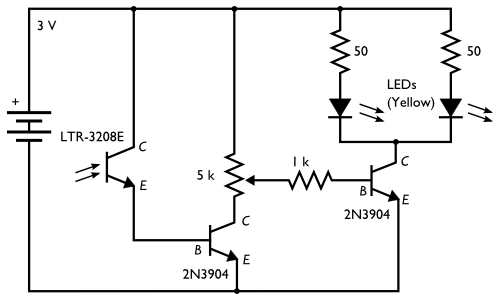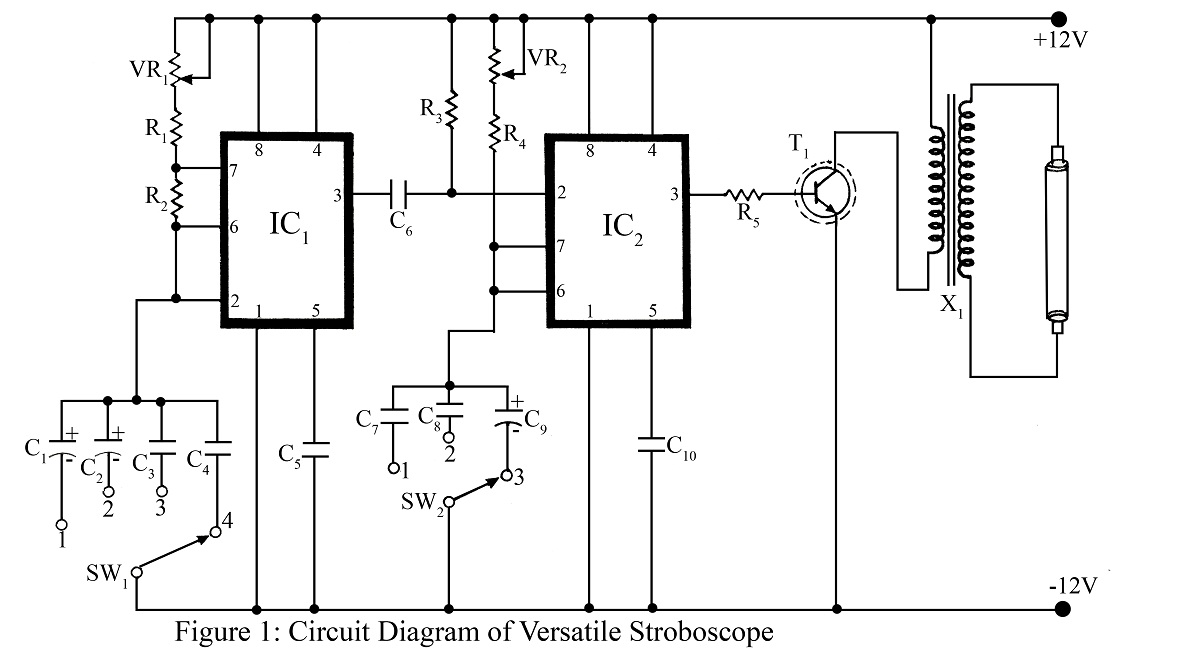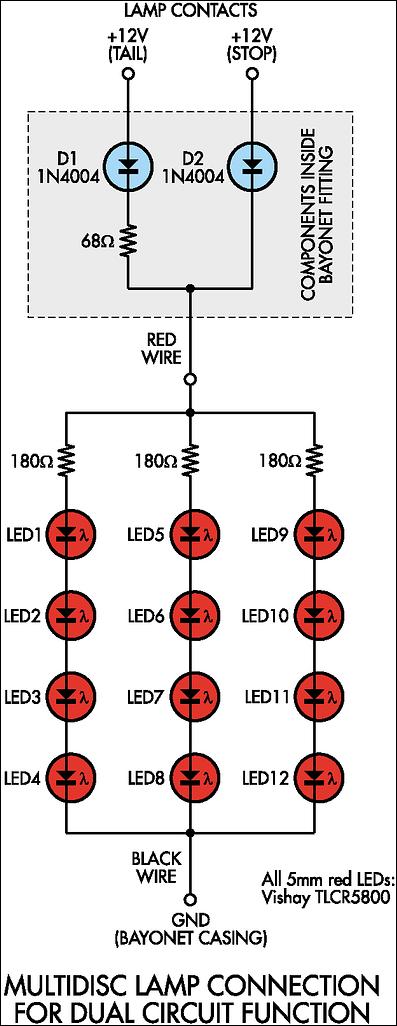
Brake Light Signal Module

Circuits of this type are designed to drive LED arrays to enhance visibility and conspicuity when a vehicle is stopped or slowing down. This specific circuit emits a visual alert signal consisting of four short flashes followed by a steady light that remains illuminated as long as the brakes are engaged. The internal oscillator of IC1 generates a square wave frequency that is divided by 64 through the flip-flops within the chip to achieve a frequency of approximately 1 to 4 Hz at pin #4. This frequency corresponds to the flashing rate of the LED array and can be adjusted to the desired value using resistor R3. A positive signal at the cathode of diode D1 halts the oscillator after five pulses are counted. Capacitor C2 and resistor R1 automatically reset the IC whenever the brakes are applied. Transistor Q1 serves as the LED array driver, ensuring that the LEDs are illuminated when pin #4 of IC1 goes low.
The circuit operates by utilizing an integrated circuit (IC) that features an internal oscillator capable of producing a square wave signal. The frequency of this signal is crucial as it determines the flashing rate of the LED array. By employing flip-flops, the output frequency at pin #4 is effectively reduced, allowing for a controlled flashing pattern of the LEDs. The adjustment of resistor R3 provides flexibility in setting the desired flashing frequency, accommodating various visibility requirements.
When the brakes are applied, a positive signal is fed to the cathode of diode D1, which triggers the circuit to count five pulses before stopping the oscillator. This mechanism ensures that the LED array only flashes for a predetermined duration, enhancing the effectiveness of the visual alert. The combination of capacitor C2 and resistor R1 plays a pivotal role in resetting the IC, allowing the system to react promptly to the application of the brakes.
Transistor Q1 is employed as a driver for the LED array, providing the necessary current to illuminate the LEDs. The design ensures that when pin #4 of IC1 transitions to a low state, Q1 is activated, allowing current to flow through the LED array and illuminating the lights. This configuration not only enhances the visibility of the vehicle but also ensures that the alerting signal is clear and effective for other road users. Overall, this circuit design prioritizes safety and visibility, making it an essential component for vehicles in situations where stopping or slowing down may pose a risk to both the driver and other road users.Circuits of this kind are intended to drive LED Arrays in order to create more visibility and conspicuity when a vehicle is stopped or stopping. This circuit, in particular, will emit a visual alerting signal of 4 short flashes, followed by a steady on light that remains steady on as long as the brakes are applied.
IC1 internal oscillator generate s a square wave whose frequency is divided 64 times by the flip-flops contained in the chip in order to obtain about 1 to 4Hz at pin #4: this is the LED Array flashing frequency and can be set to the desired value by means of R3. A positive signal at D1 Cathode stops the oscillator after 5 pulses are counted. C2 and R1 automatically reset the IC whenever the brakes are applied. Q1 is the LED Array driver: LEDs will be on when pin #4 of IC1 goes low. 🔗 External reference
The circuit operates by utilizing an integrated circuit (IC) that features an internal oscillator capable of producing a square wave signal. The frequency of this signal is crucial as it determines the flashing rate of the LED array. By employing flip-flops, the output frequency at pin #4 is effectively reduced, allowing for a controlled flashing pattern of the LEDs. The adjustment of resistor R3 provides flexibility in setting the desired flashing frequency, accommodating various visibility requirements.
When the brakes are applied, a positive signal is fed to the cathode of diode D1, which triggers the circuit to count five pulses before stopping the oscillator. This mechanism ensures that the LED array only flashes for a predetermined duration, enhancing the effectiveness of the visual alert. The combination of capacitor C2 and resistor R1 plays a pivotal role in resetting the IC, allowing the system to react promptly to the application of the brakes.
Transistor Q1 is employed as a driver for the LED array, providing the necessary current to illuminate the LEDs. The design ensures that when pin #4 of IC1 transitions to a low state, Q1 is activated, allowing current to flow through the LED array and illuminating the lights. This configuration not only enhances the visibility of the vehicle but also ensures that the alerting signal is clear and effective for other road users. Overall, this circuit design prioritizes safety and visibility, making it an essential component for vehicles in situations where stopping or slowing down may pose a risk to both the driver and other road users.Circuits of this kind are intended to drive LED Arrays in order to create more visibility and conspicuity when a vehicle is stopped or stopping. This circuit, in particular, will emit a visual alerting signal of 4 short flashes, followed by a steady on light that remains steady on as long as the brakes are applied.
IC1 internal oscillator generate s a square wave whose frequency is divided 64 times by the flip-flops contained in the chip in order to obtain about 1 to 4Hz at pin #4: this is the LED Array flashing frequency and can be set to the desired value by means of R3. A positive signal at D1 Cathode stops the oscillator after 5 pulses are counted. C2 and R1 automatically reset the IC whenever the brakes are applied. Q1 is the LED Array driver: LEDs will be on when pin #4 of IC1 goes low. 🔗 External reference
Warning: include(partials/cookie-banner.php): Failed to open stream: Permission denied in /var/www/html/nextgr/view-circuit.php on line 713
Warning: include(): Failed opening 'partials/cookie-banner.php' for inclusion (include_path='.:/usr/share/php') in /var/www/html/nextgr/view-circuit.php on line 713





